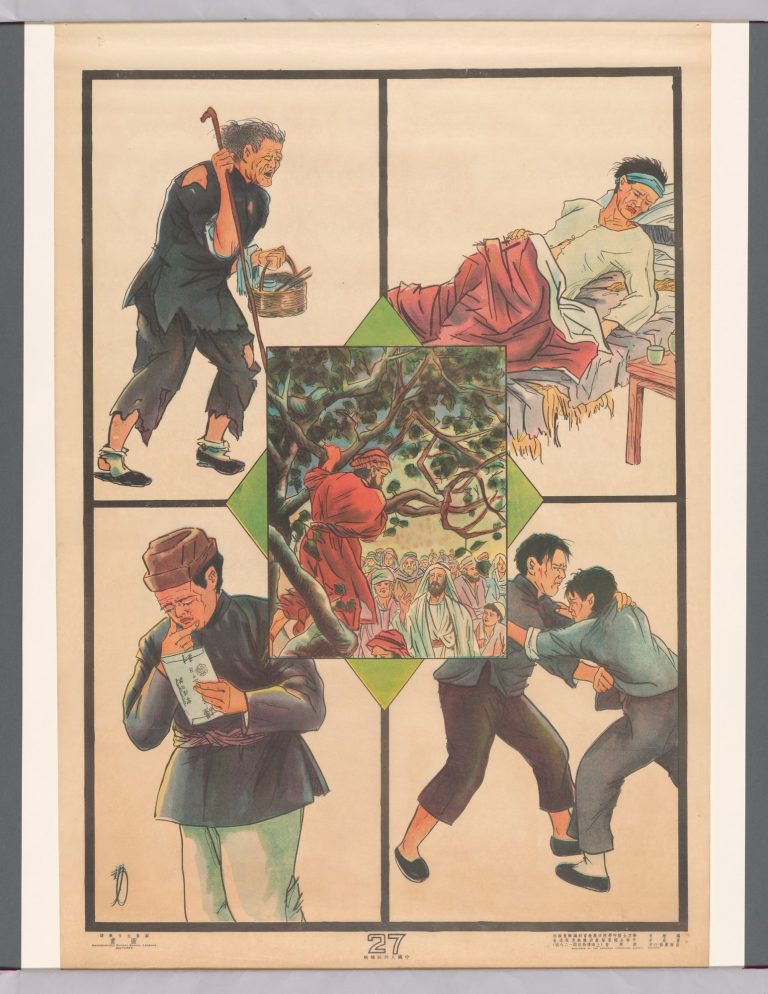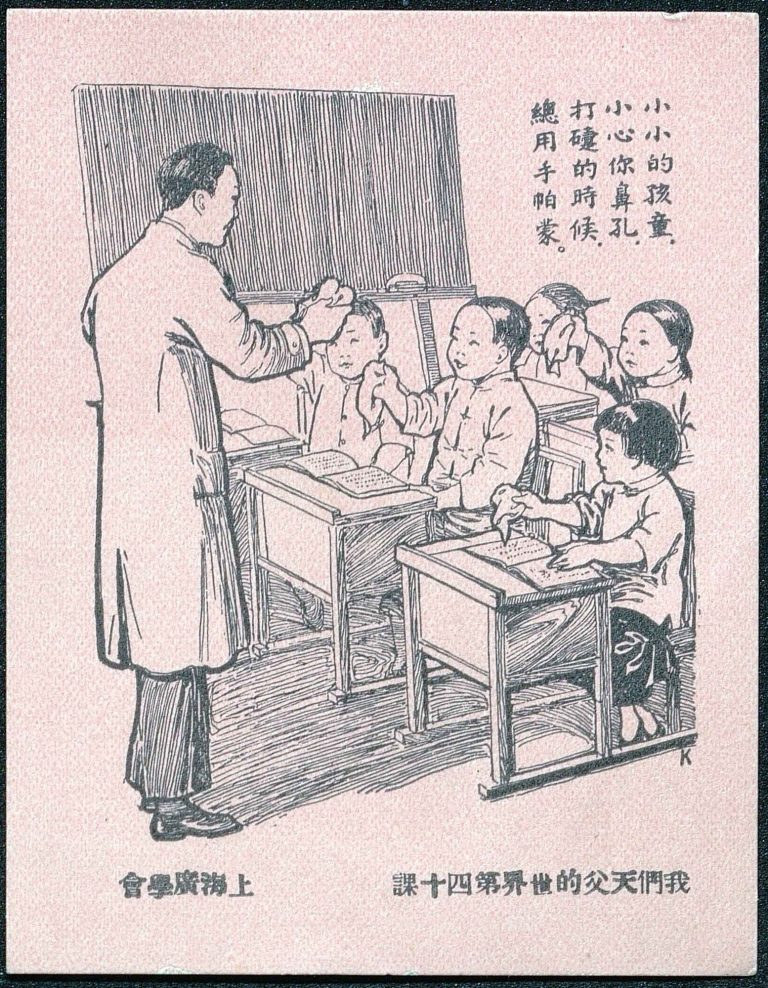What strategies did the Christians employ on teaching cleanliness, and why were they effective?
Since foreign Christian missionaries first came to China, their main goals were to impart their religious and cultural beliefs onto their converts. As such, it is no surprise that the western Christians also tried to enforce their narratives and ideas of western medicine and habits of cleanliness as well. In this exhibit, I will be going through four posters created by Christians in China that are either explicit step-by-step guides, or an informational that display how to conduct oneself as a productive member of society. I will be exploring why these posters were effective as well as what tactics the Chinese Christians used to reach their audiences.
How to Kill Flies

How to Kill Flies was originally used in a Sunday school to teach children habits of cleanliness. This poster is quite unique as it depicts the life cycle of a fly, where they congregate, and how to best get rid of them. When I first looked at this poster, I thought it was odd that someone would need to show a guide on how to kill flies. However, in actuality, it makes a lot of sense why one might teach it because as “children were already in a position of receiving instruction, Sunday school posters could include lessons on the lifecycle of the fly and depict children actively killing flies to prevent the spread of disease” (Mih Tillman 98). Children are at an age where they are most susceptible to influence, and will usually follow what an authority figure will say. In order to change the cleanliness habits of the population, you must first target the demographic most willing to do what someone says. This is why in later years, the Communist Party would target children to aid in the 4 pests campaign. In western cultures, flies were representative of death and plague, so it is easy to understand why people who subscribed to a western faith would adopt those same ideologies around killing flies.
Four Diseases of the Chinese

This is the only poster in this exhibit that is not directly being taught to children. However, this informational is still included because it teaches the public about the wrongdoings of society. Going top to bottom, left to right, each corner illustrates the the four evils of the world: poverty, sickness, ignorance, and disorder. Poverty is a hard issue to tackle because in any given society, there will always be poor people. Even so, as a public, there can be social reforms to improve the state of poverty people are living in. Sickness during this time period was one of the most impactful issues in Chinese society. Anyone could get sick, and anyone could die. With the introduction to western medicine and the spread of vaccinations, people were able to live more fulfilling lives. Next, with ignorance, I will focus more on the grievances people had around superstitions. At the time, many people were wary of western medicine and the Christian ideas being presented. To be Christian was to be well educated, so it makes sense as to why at Chinese Christians were so opposed to being uneducated or ignorant. Finally, disorder can be a broad term, but I will stick with the idea of disorder among the people. In Christianity, it is imperative to “love thy neighbor as yourself” so when Chinese Christians would see the strife and hatred between people, it makes sense as to why they would condemn fighting and disorder between people. One key point of interest is that in this poster, in the very center you can see Jesus looking at Zacchaeus in a tree. This is a great analogy that they are making because in the bible, Zacchaeus was looked down upon because he was a tax collector, yet Jesus wanted to meet with him because he was still a follower of Christ. The connection the illustrator was trying to make is that anyone can come to the word of Jesus, regardless of background or social standing, and that Christ will look past your sins or living conditions, which would be favorable to the masses as most people fit into one of these categories.
Children's Health

This third poster follows the same structure as the Four Diseases of the Chinese, and was made by the same illustrator as well. To jump right in, this poster relays the exact opposite information as the previous poster. While the Four Diseases focuses on the wrongs of society, Children’s Health focuses on how to keep your body clean and hygienic. Healthy habits always start from a young age, the older you get, the harder it is to enforce new habits. Subsequently, the Chinese Christians targeted children for this teaching, as it would likely have been taught or hung in a Sunday school. The pictures go as follows, washing your body in a clean tub, brushing your teeth, spitting in a basin and not on the floor, washing clothes in warm water, and in the center, eating a balanced and nutritious meal. Disease was the leading cause of death in China, so it is no surprise why Chinese Christians were pushing for healthier people. It can also be noted that this would have also had an impact on the parents and families of the children who would practice healthy habits. Hearing that your child had a better chance of survival because of having them take care of their bodies would increase the chances that the whole family would start practicing these routines as well. Changes to taking care of ones body was effective as “the cause-of-death data available for Beijing in the early part of the [20th] century confirms the impression that the reductions in mortality occurred as the result of local public health interventions” (Campbell 201). As a result, many people’s standard of living improved as they were healthier, less likely to get sick, and in the eyes of the Chinese Christians, were being better followers of Christ.
Mind Your Nose

This final poster is Mind Your Nose, created by Beatrice Kitchen who’s specialty is in creating illustrations of Chinese Christian children. The poster shows a class learning from their teacher on how to use a handkerchief and reads “Small Little Child, Mind Your Nose; Whenever You Sneeze, Always Cover It with a Handkerchief”. At the bottom of the poster, the text denotes that this was lesson 40, which means that there were many more small teachings like similar to this poster. I would say that this poster is particularly effective for a couple reasons. The first being that it most likely would have been taught in a class. Like the majority of the other posters in this exhibit, this poster is targeted towards children, I feel that I would be beating a dead horse if I kept reiterating why that was effective, so I will move on to my next point. The classroom is depicted as entirely Chinese, with a Chinese teacher and Chinese students. This kind of poster, I feel, would be much better accepted by Christians and non-Christians alike because it is more relatable. Having a Chinese teacher rather than a westerner teaching these things would have a huge impact on how people responded to this. Having comfort in familiarity would make it easier for the public at large to trust what this poster is saying. When western medicine first came into China it is noted “that foreign medicine is
sometimes described as dangerous medicine” (Xu 3). Foreign things are often perceived as dangerous, because you might not be familiar with it, so it makes sense why Chinese society would be wary of these new ideas and techniques. However, since it is being led by a Chinese citizen, it can be viewed as more trustworthy and inherently safe. Even something as simple as blowing your nose into a handkerchief could be a new thing to learn, and what better way to do it from someone you can trust?
Works Cited
Campbell, Cameron. “Public Health Efforts in China before 1949 and Their Effects on Mortality: The Case of Beijing.” Social Science History 21, no. 2 (1997): 179–218.
Mih Tillman, Margaret. “Childhood: The Foundation for True Health.” Essay. In Visions of Salvation, 89–109. ed. Ireland, Daryl. Waco, Texas: Baylor University Press, 2023.
Xu, Yufan. “Boundaries and Classification: The Cultural Logic of Treating Foreign Medicine.” Humanities & Social Sciences Communications, 2024: 1–7
